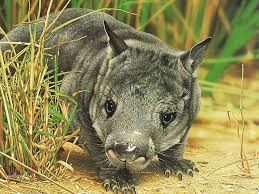The Northern Hairy-Nosed Wombat is only found in one place in the entire world—the Epping Forest National Park in Australia—where only 115 (recorded in 2005) still live in the wild and none live in captivity. They only reside on sandy terrain, another reason why the population is so limited. They dig intricate, 1 meter by 2 meter sandy mounds, most with multiple entrances. Up to ten of these species of wombat can live together in the burrow, but each burrow residence has an equal number of female and male wombats. These burrows contain multiple wombat living quarters inside of them. Females will room together while the males prefer to room solo. These burrows are quite comfortable for wombats, as their depth ensures a constant temperature and humidity level that these nocturnal species prefer.
The Northern Hairy-Nosed Wombat can live for up to 23 years in the wild. Baby wombats are generally born during Australia’s rainy season (between November-April). The rainier the season, the more wombat babies born. Like other marsupials, baby wombats spend their first months chilling in mommy wombat’s pouch, generally somewhere between 8 and 9 months. By 12 months, wombat babies are all grown up and ready to venture out on their own.
On average, northern hairy-nosed wombats weigh in at 32 kg (about 70 pounds) and can grow up to a meter in length. These fuzzy (even their noses are covered in fuzz!), grey, chubby-looking creatures have broad heads and short, strong limbs that they use to burrow. They do not feed every day because they have such a low metabolism, but do enjoy foliage and a wide variety of grasses when they do so. Though these guys don’t need to eat every day, it is known that they can spend up to 6 hours a night in winter and 2 hours a day in summer munching away on grass (however, a kangaroo of their size can spend up to 18 hours a day doing the same).
Dingoes are these guys’ worst enemy, along with forest fires that wipe out their food supply, drought, and their extremely low population. However, Australian efforts are working on conservation and identification plans to replenish this species of wombat.


